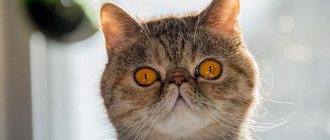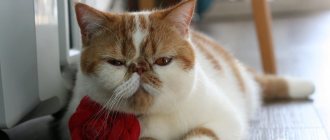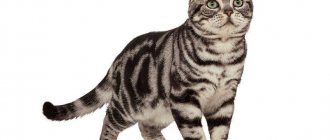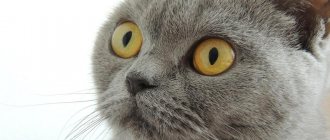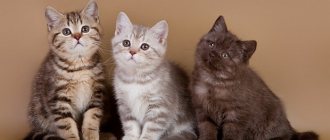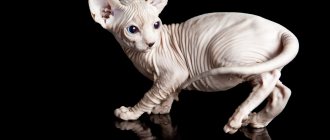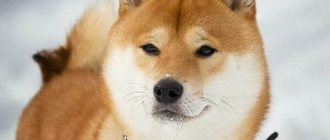- Posted by Yana Gavrikova
- Date: May 15, 2018
An exotic cat is an almost complete copy of a Persian cat. The differences are a very flattened nose and short hair. This breed was bred from the Persians, and it inherited some of their features.
- 2 External features
2.1 Photo gallery: exotic cat
- 6.1 How to organize a toilet for a cat
- 7.1 Castration and sterilization of the breed
History of exotics
The breed dates back to the 1960s. The breeding of unusual cats happened by accident, since the original goal of the breeders was to improve the qualities of the American Shorthair by crossing with Persians. The main goal was to improve the quality of wool and obtain a wider range of colors. However, as a result of such mating, the offspring turned out to have an exotic appearance - short legs and neck, thick build, characteristic muzzle, snub nose. But despite the large number of traits inherited from the Persian breed, exotics did not receive long hair.
The Exotic Shorthair has been officially registered with most major cat associations. Initially, a proposal was put forward to name the breed “sterling”, that is, “silver”, however, this idea was abandoned.
Character
As in many other things, exotic cats are similar in character to Persians: they are quiet, domestic, calm and loving animals. Exotics love human attention very much; they can easily climb onto your lap at any moment. They love to sleep with their owner, perhaps even on him. Exotics are agile and inquisitive, active, love to play, and are happy to run after a bow on a string or chase a ball. The breed is not at all aggressive, so it easily gets along with children or animals, even dogs. The Exotic is a very loyal breed; it will always meet its owner after an absence. He is wary of strangers, but only at first. If the cat understands that there is no danger, then it calmly makes contact.
Exotics get along well with other animals and people
In fact, every cat has its own character. A friend of mine has a cat and an exotic cat. The cat loves to sit in your arms, loves affection, always purrs and will come running and climb on your arms or neck. The cat is wayward, rarely approaches anyone, and will sit in your arms only if you catch it yourself. If you call her, she will pretend to be deaf.
Description of exotics
Representatives have not only a cute appearance, but also an easy-going character. Therefore, this breed is very common throughout the world.
Appearance
Externally, exotic shorthairs are similar to Persians. Cats are small in size, but have a dense, stocky build. One of the features is the short neck - despite the usual number of vertebrae for mammals, visually it seems that the head grows from the shoulder girdle. The weight of males reaches 7-8 kg, females weigh about 5 kg.
The main characteristic feature is a specific muzzle - representatives of the breed have large expressive eyes, pronounced cheeks and a snub nose, as well as a flattened muzzle. This structure gives exotic shorthairs a special charm.
Coat color is variable and has no clear restrictions. The hair, unlike Persians, is short, which makes it easier to care for the animal, but at the same time the cats look plush.
Exotic character
Exotic shorthairs have an easygoing disposition. These animals are friendly and love to spend time with their owner. Cats are kind to children, so an exotic cat will become a faithful friend for a child. Representatives of the breed are not characterized by aggression.
Despite their calm nature, exotic shorthairs differ from Persians in their more playful disposition - pets love active games. Cats love attention and affection, so they do not tolerate loneliness and separation from their owner. Representatives of the breed are very loyal to their owner; when meeting a new person, they can avoid contact with him for a long time.
External features
Exotic cats are very similar in appearance to Persians. The body is strong, stocky, height at the withers reaches 30 cm. The head is large and round, erect ears are medium in size. Large eyes, blue to amber brown in color.
A striking difference is the flattened nose and large cheeks; these two signs give the cat a doll-like appearance. The tail of exotics is long and moderately fluffy. The coat is short, plush, thick. Different colors: blue, white, marbled, cream, red, black, brown. The weight of an adult exotic can reach 5 kg.
Photo gallery: exotic cat
The exotic cat has adopted the good-natured character of the Persians, this is the most affectionate and loving breed
External features of exotics are large eyes, short hair and chubby cheeks.
The eye color of exotics depends on the coat color; the brighter the color, the brighter and more saturated the eye color
Exotics are wary of new people, but if over time they realize that there is no danger, they calmly make contact
Breed standards
Standard is a description of the external characteristics of an animal, the presence of which allows not only to classify it as a given breed, but also allows participation in championships and exhibitions. For exotics, American criteria are used:
- small body size, dense constitution, shape close to a rounded square;
- the length of the limbs is the same, the paws are large;
- the tail is small;
- the head is round, the ears are small, located closer to the plane of the muzzle;
- muzzle flattened;
- snub nose;
- large round eyes, located in line with the nose;
- pronounced cheeks, slightly lowered;
- short but thick coat of any color.
Nutrition
Feeding your pet does not mean adhering to strict rules. However, exotic animals have an increased appetite, as well as a tendency to gain excess weight, so it is important that the owner does not follow the pet’s lead and does not increase the prescribed amount of food or frequency of meals. Obesity leads to the development of diseases of the cardiovascular system and endocrine diseases, and, consequently, to premature death.
Another feature of feeding exotic shorthairs is the special shape of bowls. This is due to the flattened face of cats. When eating, due to the peculiar structure of the facial part of the skull, the fur gets dirty, so it is recommended to use bowls with edges curved inward.
Quantity and composition of food
Experts recommend feeding exotic animals with premium food. Such ready-made mixtures contain all the necessary nutrients. Dry food can be combined with the use of canned food for cats.
When choosing natural food, you need to consult with a veterinarian who will select the right diet. The diet should include beef, stewed vegetables, boiled chicken, and dairy products.
It is forbidden to feed pets fried, smoked, salty foods. Also, experts do not recommend giving your pet fish and milk.
How many times a day should you feed your pet?
An adult is fed twice. At the age of 3 months, six meals a day are indicated; until six months, the frequency of feeding is reduced to 4 times a day. Upon reaching 9 months, they switch to feeding twice a day.
The role of a balanced diet in cat health
Getting all the necessary nutrients from food is important to keep your cat healthy. A lack of proteins leads to a decrease in the number of muscle cells, a decrease in immune status, dysfunction of vital organs, and deterioration in the quality of hair and skin. A lack of carbohydrates leads to a decrease in the pet’s activity and disruption of energy metabolism. Deficiency of vitamins and microelements causes the occurrence of many diseases.
In addition, the quality of feed plays a big role in the condition of the digestive system. Improper feeding can lead to constipation or diarrhea, the development of gastritis, peptic ulcers, colitis and other ailments.
Buy an exotic kitten
To find out how much an exotic cat kitten will cost, you should understand what its price consists of:
- appearance, compliance with the description according to the standard;
- “purity of blood” - kittens from parents with the title of champions are many times more expensive;
- rarity and beauty of color;
- care activities carried out by the breeder, including medical examination, sterilization, castration and vaccination;
- seller: elite nurseries with a good reputation guarantee the purity of the breed, but kittens sold on Avito, Yula and other free trade sites may cost less. Please be aware that such a purchase does not come with any guarantees.
Thus, the absence of a pedigree reduces the cost of a cat - it is quite possible to buy a supposedly exotic cat, and when its fur, cut by an unscrupulous seller, grows back, it turns out that it is an ordinary Persian cat.
buy exotic at a price of 15,000-50,000
rubles
Nicknames for exotic cats
The purchase of a kitten immediately forces the owners to start coming up with a suitable and beautiful nickname for it. To choose the right name for your fluffy bundle of joy, there is no need to rush.
global $ads_google; //data-ad-slot=”2475549904″ $ads_google = empty($ads_google) ? false : true; ?> if ($ads_google == false) {?> $ads_google = true; ?> } ?>
Cats get used to a good nickname quickly and react well to it. It is believed that a meowing friend only hears the first three sounds in his name. If you are guided by such information, then you should choose nicknames where the first part of the name will set the tone. Otherwise, the cat will respond better to “kitty-kitty” than to the name given by the owners.
The character and color of the young big-eyed purr also plays an important role in such an important matter.
To decide what to name an exotic boy or girl, you should first familiarize yourself with the best names.
| Girl | Boy | ||
| Laura Barbie Paprika Redhead Gemera Justina Rada Vita Yalta Desi Helly Frosya Varya Ruby Bella | Musya Tracy Businka Ulana Krosha Anta Lapka Claire Frida Chucha Korni Leila Irma Diana Fufa | Kuzya Renault Wolf Raisin Cam Nils Jazz Coconut Chubais Jaco Emir Lace Azar Vermouth Mot | Draco Velez Joy Simon Austin Bolt Maurice Pie Pirate Gosha Snowball Noir Tom Pepper Fay |
Appearance care
Exotic shorthairs do not require complex care, but there are some peculiarities.
Brushing and bathing
Exotics are recommended to be bathed approximately once every two to four months. To wash the thick undercoat, you should use specialized shampoos, which can be purchased at veterinary pharmacies or a pet store. You cannot use shampoos intended for humans, soaps and household chemicals, as the animal may have an allergic reaction.
To add shine to the coat, experts advise rubbing the hair with a suede cloth. Since exotic shorthairs have a flattened muzzle, pets often get their chin dirty while eating, so it is necessary to periodically wipe the contaminated areas with a napkin. Animals are combed once a month with a special brush.
Eye care
The eyes are a weak point for exotics. This breed of cat often suffers from inflammatory diseases of the conjunctiva and other pathologies, so hygiene procedures should be carried out regularly. Wash your eyes using a specialized product. After the procedure, the hair is dried and powder is applied using a cotton pad or swab. This product contains an antibacterial compound that helps prevent infectious eye diseases that exotics are susceptible to.
Ear care
To keep your ears healthy, it is recommended to perform hygiene procedures once a week. Using a special antiseptic applied to a cotton pad or gauze, wipe the inner surface of the ears. At the end of the manipulation, you can use antibacterial powder.
Nail trimming
The procedure is performed as the claws grow - approximately once every two to three weeks. Do not use regular scissors, as they may damage the soft tissue of your fingers. For manipulation, you should purchase special nail clippers.
Oral care
Prevention of dental diseases involves caring for your pet’s oral cavity. You should brush your teeth at least once every 7-10 days using a special brush. If plaque appears, you should contact your veterinarian.
Necessary purchases
- The tray should not be very large and without a grid so that the pet can dig the filler without experiencing obstacles.
- Among fillers, preference is given to compressed sawdust.
- Since exotic shorthairs have a playful character even as adults, you should stock up on toys. When choosing, pay attention to the absence of sharp and small parts that the cat can swallow.
- A scratching post is an important element that is necessary for the safety of furniture. To teach a kitten to sharpen its claws in one place, you can use special sprays.
Breed defects
Exotics are predisposed to a number of diseases. Due to the fact that the breed originates from Persian cats, their diseases are similar.
Exotic diseases
A flattened muzzle and upturned nose cause frequent diseases of the nasopharynx. The incorrect structure of the nasal passages is a favorable environment for the growth and reproduction of pathogenic microorganisms that cause the formation of an inflammatory reaction. Breathing disorders and pathologies of the nasolacrimal duct also often occur.
Conjunctivitis and other eye diseases are common in Exotic Shorthairs as a result of the eyeballs protruding excessively from the sockets. Regular preventive measures to eliminate contamination in the orbital area reduces the risk of developing illnesses.
Among the diseases of the oral cavity, the most frequently recorded are tartar, caries, inflammation of the pulp and gums. These pathologies require treatment by a veterinary dentist.
Hypertrophic cardiomyopathy is usually a congenital disease. In this case, thickening of the chambers of the heart occurs, disruption of its function and hemodynamics, which can result in death at an early age against the background of relative health.
Diseases of the genitourinary system are widespread in all breeds of cats, however, exotic cats are susceptible to the development of polycystic kidney disease - a disease characterized by the formation of multiple cysts.
Often a change in the lower jaw is recorded in the form of its skew. This pathology reduces chewing function, and the cat may refuse to eat. In addition, improper jaw position increases the risk of developing dental diseases.
Defects in appearance
There are some changes in signs in one direction or another, which exclude the pet from participating in competitions and exhibitions. Such defects include a change in the number of toes on the paws: there should be five phalanges on the front, and four on the back. Also, a cat with creases in its tail will not be able to receive the title. A defect in appearance is considered to be a change in the proportions and symmetry of the head and body, as well as strabismus in a cat.
Health
Exotics are susceptible to a number of potential health problems, most often related to their facial features:
- difficult or noisy breathing associated with narrow nostrils;
- malocclusion - teeth do not touch each other;
- eye diseases such as cherry eye and entropy;
- polycystic kidney disease - a genetic test can be performed to diagnose it;
- predisposition to ringworm, fungal infection;
- Seborrheic dermatitis is a skin condition that causes itching, redness and hair loss.
Any of the pathologies should be treated exclusively with the means prescribed by the veterinarian.
Table: pros and cons of the breed
| pros | Minuses |
| Kind character, love affection and attention, relate well to small children, playful and unforgiving | Susceptible to a wide range of diseases |
| Have a cute appearance | Requires regular eye and ear hygiene |
| Exotics do not require complex grooming | The fur in the area of the flattened muzzle often gets dirty |
| Do not show aggression | The high cost of kittens |
Conclusions about shorthaired exotics
It is not for nothing that the exotic shorthair cat has earned the love and respect of its fans. There are a lot of good things to say about the breed, but it’s worth considering all the pros and cons:
- The soft fur and fluffiness of plush wool are wonderful assets, but require care;
- large round eyes and the structure of the muzzle are the hallmark of the breed, although this brings some problems;
- if you monitor the health of cats, you can prevent many diseases and avoid unnecessary difficulties;
- The nature of the pets is affectionate and friendly.
As you can see, many people love the cutie exotic for its obvious advantages over other representatives of the cat world.
Cost of an exotic kitten
The average price for one exotic kitten as a pet is 50 thousand rubles. If the pet has a breeding defect - shortcomings that preclude its use for breeding, the cost is reduced several times.
Animals for breeding and show class are much more expensive than pet class pets.
It is not recommended to purchase kittens secondhand via the Internet or through an advertisement for sale. A reliable option is to buy exotics from a nursery.
Photo gallery of the exotic breed:
1111
